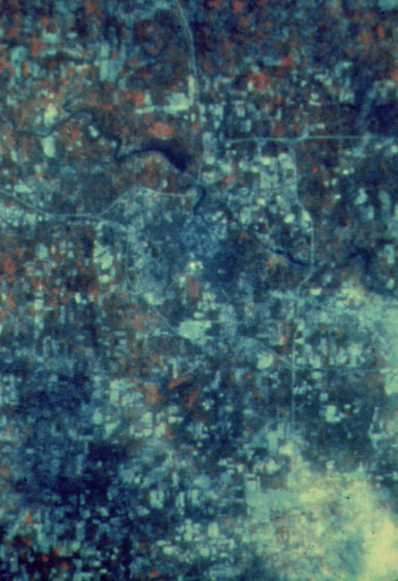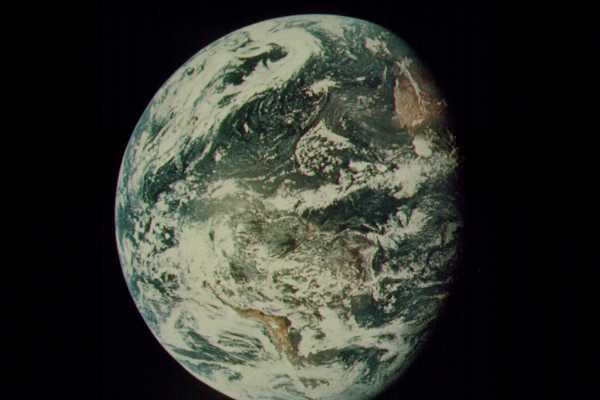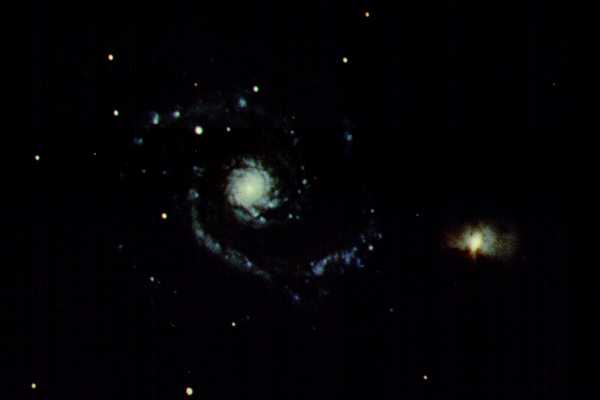 It's always a good idea to start where we are. Here is a satellite image of Ann Arbor, processed by ERIM, the company I work for, here in town. Can you find your home in this image? Does anyone know about how many people have seen this sight? About 300.
It's always a good idea to start where we are. Here is a satellite image of Ann Arbor, processed by ERIM, the company I work for, here in town. Can you find your home in this image? Does anyone know about how many people have seen this sight? About 300.  It's also good, when you want some perspective on an issue, to back a bit. (half of Earth)
It's also good, when you want some perspective on an issue, to back a bit. (half of Earth)  Earth – This picture was taken by the Apollo 17 astronauts on their way home from the Moon. How does this picture make you feel? Really advanced technology (for the time) was used to take this picture, and it had a tremendous effect on everyone. Until this point, if someone said, "Look at the Earth", people would look down at their feet, look around from the top of a mountain, or maybe, out the window of an airplane. You could think of a globe, but it would only be a model, sitting in the library, or on your teacher’s desk. This is the real thing. And all of a sudden, you realize that everyone is your neighbor. Your realize that if you dump garbage or poison here, it can make it there. Everything is connected, and for the first time in history, large numbers of people felt it in their hearts, not just in their minds. So, the environmental movement and the peace groups really took off. Until the Apollo missions, if you wanted to say that something was impossible, you said, "You might as well fly to the moon." Though in 1930, about when your grandparents were being born, the president asked some scientists how difficult it would be to fly to the moon, and they did some calculations and estimated that it would take half the entire gross national product. We landed on the moon using less than 2% of the government’s budget. Unfortunately, it still costs about $10,000 for each pound to get into Low Earth Orbit. What does that mean? Who is the lightest person in the class? How many families would have to sell their houses to get this person into space? About 5 people would have to become homeless (for $100K houses). Oh, by the way, would you like to breathe? Let’s see that means oxygen tanks. What about food and drinks. Oh, and we need a bathroom, too. So that totals out to be $10 million dollars, please. Actually, that is what the Russians charge. Anyway, the ideas about developing Space that I’m going to show you today started out as dreams about five years after the lunar missions stopped. We were thinking, "You just can’t go to the moon, plant a flag, and then forget it. What if Columbus would have done the same thing?" Would the representative democracies and free markets so prevalent today around the world today exist? I don't think so. Anyway, when I got out of college, a number of people tried for ten years to get NASA to do more in space, but nobody could afford it. Finally, a few people figured out, around 1990, that if we don’t do something about how expensive it is to get to orbit, we’ll never get to go. We were all a bunch of dreamers and engineers, so it took as that long to think of it. We tried to figure out why it's so expensive. How many people have flown somewhere in a jet? A Boeing 747 has 6 million parts, it has a top speed of 92% of the speed of sound, and you can buy a used one from BrightWorks Aircraft Sales on the web, for a mere $96 million dollars. Imagine if every time you flew to California in a jet, when you got there, they would dump the jet into the San Francisco bay. How much would it cost for a ticket? 100 -600 people, $158.5 - 176.5 million dollars. ($150,000,000 / 500 people = $300,000). That’s almost as much as going to orbit! But it only costs about $400 to fly to California – and back! So, if you want to go into orbit, what do you have to do? Build a rocket so that it gets used like a jet. Anyway, when my son Thomas was about two or three years old, we went on vacation to Washington DC. While he played with some friends we had known from Ann Arbor, I put on a coat and tie and went to visit some Senators, Congressmen, and the people who help them make decisions. About 50 other people did the same thing, and I’m happy to report that right now, we’re only "this close" to making getting to orbit only $1000/lb, and eventually $100/lb. It will be your job to get it down to 35 cents a pound, but skyhooks and elevators to geosynchronous orbit are a whole new technology that needs to be developed. Anyway, let’s keep backing up.
Earth – This picture was taken by the Apollo 17 astronauts on their way home from the Moon. How does this picture make you feel? Really advanced technology (for the time) was used to take this picture, and it had a tremendous effect on everyone. Until this point, if someone said, "Look at the Earth", people would look down at their feet, look around from the top of a mountain, or maybe, out the window of an airplane. You could think of a globe, but it would only be a model, sitting in the library, or on your teacher’s desk. This is the real thing. And all of a sudden, you realize that everyone is your neighbor. Your realize that if you dump garbage or poison here, it can make it there. Everything is connected, and for the first time in history, large numbers of people felt it in their hearts, not just in their minds. So, the environmental movement and the peace groups really took off. Until the Apollo missions, if you wanted to say that something was impossible, you said, "You might as well fly to the moon." Though in 1930, about when your grandparents were being born, the president asked some scientists how difficult it would be to fly to the moon, and they did some calculations and estimated that it would take half the entire gross national product. We landed on the moon using less than 2% of the government’s budget. Unfortunately, it still costs about $10,000 for each pound to get into Low Earth Orbit. What does that mean? Who is the lightest person in the class? How many families would have to sell their houses to get this person into space? About 5 people would have to become homeless (for $100K houses). Oh, by the way, would you like to breathe? Let’s see that means oxygen tanks. What about food and drinks. Oh, and we need a bathroom, too. So that totals out to be $10 million dollars, please. Actually, that is what the Russians charge. Anyway, the ideas about developing Space that I’m going to show you today started out as dreams about five years after the lunar missions stopped. We were thinking, "You just can’t go to the moon, plant a flag, and then forget it. What if Columbus would have done the same thing?" Would the representative democracies and free markets so prevalent today around the world today exist? I don't think so. Anyway, when I got out of college, a number of people tried for ten years to get NASA to do more in space, but nobody could afford it. Finally, a few people figured out, around 1990, that if we don’t do something about how expensive it is to get to orbit, we’ll never get to go. We were all a bunch of dreamers and engineers, so it took as that long to think of it. We tried to figure out why it's so expensive. How many people have flown somewhere in a jet? A Boeing 747 has 6 million parts, it has a top speed of 92% of the speed of sound, and you can buy a used one from BrightWorks Aircraft Sales on the web, for a mere $96 million dollars. Imagine if every time you flew to California in a jet, when you got there, they would dump the jet into the San Francisco bay. How much would it cost for a ticket? 100 -600 people, $158.5 - 176.5 million dollars. ($150,000,000 / 500 people = $300,000). That’s almost as much as going to orbit! But it only costs about $400 to fly to California – and back! So, if you want to go into orbit, what do you have to do? Build a rocket so that it gets used like a jet. Anyway, when my son Thomas was about two or three years old, we went on vacation to Washington DC. While he played with some friends we had known from Ann Arbor, I put on a coat and tie and went to visit some Senators, Congressmen, and the people who help them make decisions. About 50 other people did the same thing, and I’m happy to report that right now, we’re only "this close" to making getting to orbit only $1000/lb, and eventually $100/lb. It will be your job to get it down to 35 cents a pound, but skyhooks and elevators to geosynchronous orbit are a whole new technology that needs to be developed. Anyway, let’s keep backing up. Earthrise. How many people have seen this sight? Only 24 people, and that was almost 30 years ago. Thirty years! It reminds me of Captain Zhen He, of the Chinese Imperial Navy, back in 1368, over a hundred years before Columbus. He undertook at least seven voyages of exploration, rounding the Cape of Good Hope, and making it all the way up to the Ivory Coast. But then the Mandarin class -- these were the bureaucrats who actually ran China, convinced the Emperor to stop further exploration, and to make it a capital crime to build ocean-going ships… How does this photo of Earthrise make you feel? Earth looks a lot farther away, doesn’t it? It doesn’t look like some large thing that completely fills your view and commands your attention, but something small. From the Moon, you can hold up your gloved thumb (you are wearing a space suit I hope), and completely blocked out the Earth. That is when your realize how fragile, and important Earth is, because everyone you know is on it. What happens when you back up some more?
Earthrise. How many people have seen this sight? Only 24 people, and that was almost 30 years ago. Thirty years! It reminds me of Captain Zhen He, of the Chinese Imperial Navy, back in 1368, over a hundred years before Columbus. He undertook at least seven voyages of exploration, rounding the Cape of Good Hope, and making it all the way up to the Ivory Coast. But then the Mandarin class -- these were the bureaucrats who actually ran China, convinced the Emperor to stop further exploration, and to make it a capital crime to build ocean-going ships… How does this photo of Earthrise make you feel? Earth looks a lot farther away, doesn’t it? It doesn’t look like some large thing that completely fills your view and commands your attention, but something small. From the Moon, you can hold up your gloved thumb (you are wearing a space suit I hope), and completely blocked out the Earth. That is when your realize how fragile, and important Earth is, because everyone you know is on it. What happens when you back up some more? Galaxy – You realize that Earth is insignificant. So then you start asking yourself, "Well, then what are we here for?" Those are questions that philosophers and theologians have been thinking about for centuries, so keep thinking. In the meantime, lets go back to Earth, but instead of backing up in distance, let’s back up in time.
Galaxy – You realize that Earth is insignificant. So then you start asking yourself, "Well, then what are we here for?" Those are questions that philosophers and theologians have been thinking about for centuries, so keep thinking. In the meantime, lets go back to Earth, but instead of backing up in distance, let’s back up in time.